Vasto (CH), lì 22 Dicembre 2021 ore 17.00
Amici ed amiche, buonasera a tutti voi.
Gran parte delle persone che mi conoscono, sanno che le mie passioni di sempre per cui vivo è la tutela ambientale e lo sport, pratico la corsa su strada da Giugno del 1997 da più di 24 anni ed il ciclismo su strada da Marzo del 2008, ma in pochissimi conoscono un’altra delle mie passioni mai sopite che voglio condividere con voi in questo articolo: si tratta di quella che per me è la regina di tutte le Scienze conosciute, l’Astronomia!
La mia passione per l’astronomia nacque all’età di 12 anni, quando già al tempo seguivo con particolare interesse diversi interventi e convegni che teneva l’indimenticata Signora delle Stelle, la toscana Dott.ssa Margherita Hack, famosa astrofisica e Direttrice dell’Osservatorio Astronomico di Trieste e la pioniera dell’astronomia agli ultravioletti (UV<400 nm), utilizzando come metodo analitico la spettroscopia per studiare i segreti della radiazione prodotta dalla stella Epsilon Aurigae nella costellazione dell’Auriga. La Dottoressa Hack studiò da scienziata le stelle a emissione B per gran parte della sua esistenza terrena, stelle di classe spettrale B secondo il diagramma di Hertzsprung-Russell (HR), le stelle blu che emettono radiazione UV sono anche le più calde poiché la radiazione UV è più energetica di quella emessa nel visibile o negli infrarossi (IR >3000 nm), secondo la legge di Planck, il primo principio della Meccanica Quantistica che enuncia: l’energia di un fotone contenuto nella radiazione emessa dalla stella è direttamente proporzionale alla sua frequenza (ν ni) ed inversamente proporzionale alla sua lunghezza d’onda (λ lambda) secondo la seguente formula della Legge di Planck: E=h x ν dove ni = c/λ.
Io da sempre ho coltivato un’ammirazione speciale, una venerazione nei riguardi di questa donna, perché la mia passione verso questa nobile branca della Scienza contemporanea, la regina di tutte le altre Scienze, la devo soprattutto a lei, perché ho sempre sognato sin da tenera età di poter un giorno andare a lavorare in un osservatorio astronomico come il suo, alla ricerca dei misteri e dei segreti del Cosmo. Per poter osservare il Cielo profondo non bastano i propri occhi e cominciai a coltivare il desiderio di avere un telescopio tutto mio, strumento con il quale volevo vedere le stelle, i pianeti, la Luna e gli oggetti di cielo profondo (Deep Sky) come galassie, nebulose, asteroidi e comete. Nel Giugno 1997 ottenni la licenza media presso la scuola principale di Scurcola Marsicana (AQ) dove abitai dal 1991 al 2000 e chiesi ai miei genitori un regalo importante per la vita e così loro decisero di accontentare la mia richiesta, avere un telescopio tutto nuovo per me! I miei erano indecisi tra due modelli della ditta americana Meade: un rifrattore a lenti bianco ed un riflettore newtoniano a specchi della Saturn, ditta privata gestita dalla Meade, con la differenza che il primo veniva 680000 lire ed il secondo ben 900000 che al tempo erano bei soldi, era quasi uno stipendio bruciato, ma mio padre e mia madre volevano vedermi felice e così decisero insieme di acquistarmi il riflettore newtoniano nero della Saturn, che vado a mostrarvi qui di seguito: si trattava di un telescopio avente per obiettivo degli specchi, uno primario in fondo al tubo ottico ed un altro inclinato di 45 gradi posto dietro l’oculare per raddrizzare e perfezionare l’immagine che si vedeva sull’oculare nel corso dell’osservazione degli oggetti celesti.


https://www.ibs.it/mia-vita-in-bicicletta-libro-margherita-hack/e/9788865490259
Ed ecco a voi il mio telescopio newtoniano Saturn della Meade, che ho avuto in possesso da Giugno 1997 fino al 2018:

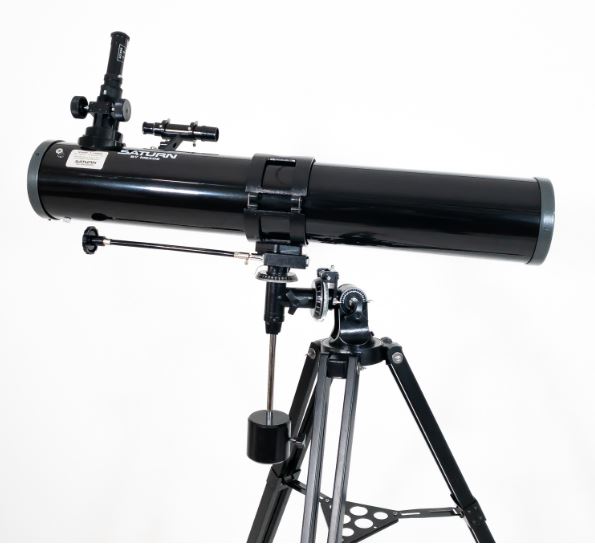



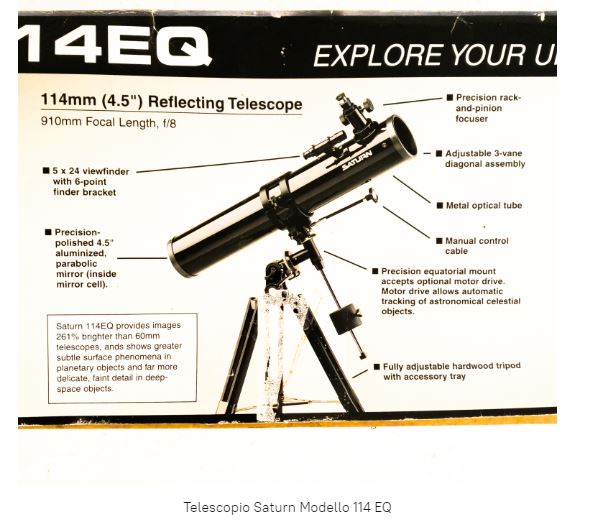


https://www.likesx.com/telescopio-saturn-by-meade-114eq/
E questo era uno dei fogli della Just Italia Srl, storica ditta svizzera produttrice di prodotti per la persona e la casa ottenuti da essenze naturali coltivate nella sede principale di Walzenhausen. Questo foglio era contenuto nel mio quadernino delle osservazioni, dove ogni sera estiva tra le 22 e le 24, annotavo tutto ciò che osservavo dalla terza finestra della mia casa di Piazza Del Mercato 1 a Scurcola Marsicana che dava su uno dei due ingressi alla piazza di Vicolo Mameli. Come vedete, sin dal 1998 fino al 2000, mi divertivo a usare la Legge di Gravitazione Universale enunciata da Sir Isaac Newton, per calcolare la forza di attrazione gravitazionale vigente tra il Sole e la Terra che si misura in Newton secondo il sistema MKS (Metro, Kilogrammo, Secondo) Sistema Internazionale dei Pesi e delle Misure.

Appena avuto il mio nuovo telescopio newtoniano nel Giugno del 1997, iniziai le mie prime osservazioni come già scritto sopra, dalla finestra della terza camera al primo piano della mia casa di Scurcola Marsicana, sita in Piazza del Mercato 1 dietro la Banca di Credito Cooperativo di Corso Vittorio Emanuele III e ricordo che in estate, alle 22 in punto, aprivo la finestra della camera ed entravo in modalità Galileo Galilei, scoprivo dalla plastica che avvolgeva lo strumento, aprivo il coperchio anteriore che chiudeva la parte anteriore dove entrava la luce nello strumento, scoprivo il tappo dell’oculare e l’osservazione aveva ufficialmente inizio. Spesso capitava che i miei amici romani villeggianti in paese che scendevano dalla parte alta del paese, venivano a bussarmi sotto casa e poi vedendomi con la finestra aperta, uno di loro, Antonio Rossi, classe 1982 romano ma da anni trapiantato a Torino, mio allora vicino di casa ed attuale titolare del bar Dopocafè a via Monferrato 18 D, diceva: “Alé, che fai stasera scendi con noi? Dai che stiamo un pò insieme!” Ed io puntualmente rispondevo: “No, stasera c’ho da fà, devo vedere il cielo notturno alla scoperta di qualche nuova stella, pianeta, per cui se volete annà in giro a donne andate, io poi in caso scendo con voi domani sera!” ed i miei amici rimanevano di stucco, allibiti, così come mio padre, che ascoltando le mie risposte date loro, lui spesso diceva a mia madre: “Ah Cà, da quanno j’avemo fatto er telescopio ad Alessio nun esce più, un ragazzo dell’età sua dovrebbe annà a fighe tutte le sere, è estate ed invece de uscì, resta dentro casa tutto solo, ma come cazzo è possibile, questo me s’è ‘mpazzito tutto insieme, sembra diventato Zichichi” e non aveva tutti i torti, ma sinceramente mio padre non ha mai voluto comprendere la stretta connessione che vige da anni tra me e l’astronomia, mentre mia madre da liceale scientifica, ha sempre assecondato ogni mia scelta, perché anche lei è appassionata di Scienza. Ricordo che qualche volta non riuscivo ad osservare bene gli oggetti celesti perché nella piazza vi era un alto grado di inquinamento luminoso che impediva di poter vedere tutti i dettagli che permetteva di vedere il telescopio, ma in condizioni normali di buio assoluto, senza luce artificiali notturne, ma avendo un lampione di ferro a luce gialla antico proprio attaccato alla finestra dietro l’anta sinistra della finestra, questo lampione mi impediva di vedere tutto quello che avrei voluto vedere, ma anche un altro parametro mi impediva di vedere al meglio gli oggetti: il seeing o grado di disturbo dell’atmosfera, infatti spesso le immagini mi tremolavano: all’inizio fu frustrante, poi piano piano mi abituai alla presenza di questo lampione e riuscì ad osservare lo stesso tutto quello che potevo osservare: le stelle del Grande Carro o Orsa Maggiore, soprattutto le finali Alkaid, Mizar, Alioth, Megrez, quelle dell’Orsa Minore e la Stella Polare la alfa:

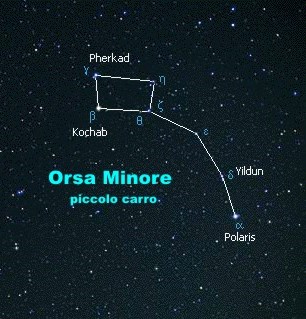
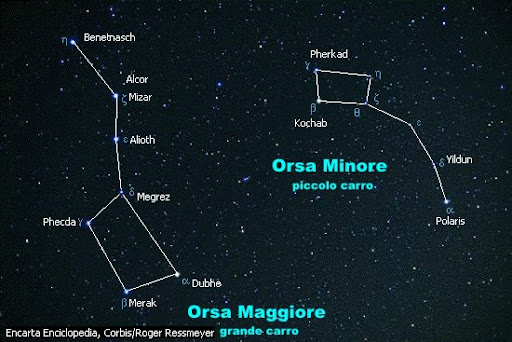
L’astronomia è una passione che continuo a coltivare ancora oggi, leggendo la mia enciclopedia cartacea Hobby & Work “Alla scoperta dell’Universo” del 1999, possedevo della stessa collana anche le VHS allegate. Sono rimasto momentaneamente senza telescopio, perché essendomi trasferito da una casa più grande di circa 92 metri quadri, dove vivevo in affitto a via Granatieri di Sardegna 18 ad Avezzano, in una casa di proprietà di appena 58 metri quadri qui a Vasto, ovviamente non avendo molto spazio a disposizione, non sapevo dove metterlo qui, per cui l’ho dovuto rivendere ad una coppia di Ciampino vicino Roma, ricordo ci venne apposta da lì per vederlo, comprarlo e portarselo via al prezzo di 250€.
http://www.arar.it/biblio/bib_vhs/bibvhs.htm
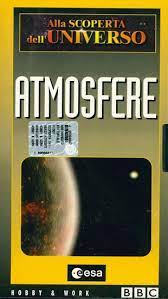

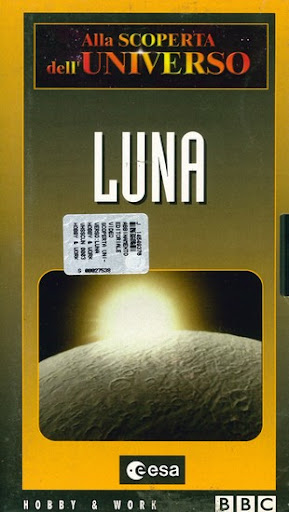




Le principali, note marche di telescopi, che si ritrovano attualmente in commercio, sono la Meade, Konus e Celestron.
https://www.konus.com/it/Catalogo/Scienza/Telescopi/
Esistono diverse architetture costruttive di telescopi che si differenziano l’una dall’altra anche all’interno della stessa categoria, ma in linea di massima, i telescopi si dividono in due categorie principali: rifrattori o riflettori: i rifrattori hanno come obiettivi delle lenti, i rifrattori hanno come obiettivi degli specchi.
https://www.skypoint.it/it/39-telescopi-riflettori
I telescopi rifrattori si suddividono in: Galilei e Keplero (apocromatici):



I telescopi riflettori si suddividono in: Newton, Dobson, Cassegrain, Schmidt-Cassegrain, Maksutov-Cassegrain.
TELESCOPIO RIFLETTORE NEWTON

https://www.astroshop.it/telescopi/10/a,Teleskope.Optik.Bauart=Newton
TELESCOPIO DOBSON NEWTON

https://www.astroshop.it/telescopi/10/a,Teleskope.Montierung.Montierungstyp=Dobson
TELESCOPIO RIFLETTORE CASSEGRAIN


TELESCOPIO RIFLETTORE SCHMIDT-CASSEGRAIN
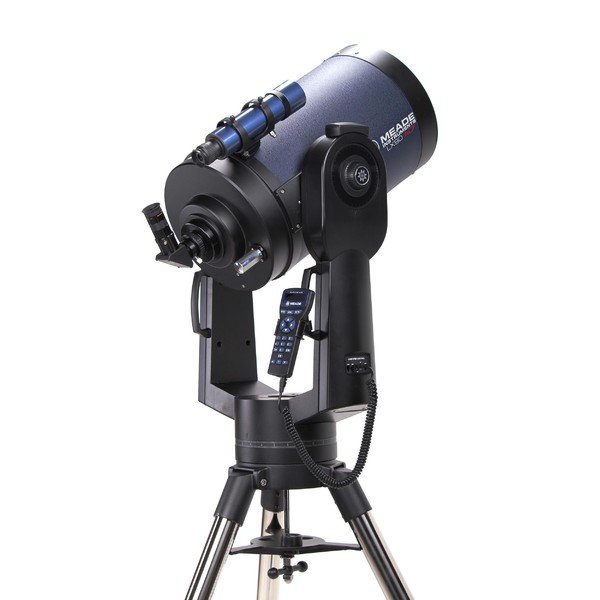

Spero che tra qualche anno sarò nella condizione ideale di potermi acquistare un telescopio riflettore Dobson perché è un tipo di telescopio riflettore molto pratico per il tipo di montatura azimutale che ha, consiste in un tubo pripale direttamente da incastonare all’interno di un supporto da fissare alle sue estremità sinistra e destra, un tipo di montatura molto semplice che permette di poter usare anche strumenti che hanno un diametro di apertura maggiore da 130 fino ai 300 mm e si può smontare facilmente per portarlo con sé ovunque e già questo aspetto, di fatto, ha influenzato molto la mia scelta finale futura, in modo da poter portare avanti una passione che coltivo dal 1997 e non si è mai sopita, neanche quando ho dovuto vendere il mio primo telescopio ad Avezzano nel 2018, una passione portata avanti da popoli storici come i sumeri, babilonesi, egizi, arabi e cinesi.
English translate
ALESSIO BRANCACCIO AND HIS PASSION TOWARDS THE QUEEN OF ALL SCIENCES, ASTRONOMY!
Vasto (CH), 22 December 2021 at 5.00 pm
Friends, good evening to all of you.
Most of the people who know me know that my lifelong passions for which I live are environmental protection and sport. I have been practicing road running since June 1997 for more than 24 years and road cycling since March 2008. but very few people know about another of my never-dormant passions that I want to share with you in this article: it is what for me is the queen of all known sciences, Astronomy!
My passion for astronomy was born at the age of 12, when I was already following with particular interest various speeches and conferences held by the unforgettable Lady of the Stars, the Tuscan Dr. Margherita Hack, famous astrophysicist and Director of the Astronomical Observatory of Trieste and the pioneer of ultraviolet astronomy (UV<400 nm), using spectroscopy as an analytical method to study the secrets of the radiation produced by the star Epsilon Aurigae in the constellation of Auriga. Dr. Hack studied B-emission stars as a scientist for most of her earthly existence, stars of spectral class B according to the Hertzsprung-Russell (HR) diagram, the blue stars that emit UV radiation are also the hottest since the radiation UV is more energetic than that emitted in the visible or infrared (IR >3000 nm), according to Planck’s law, the first principle of Quantum Mechanics which states: the energy of a photon contained in the radiation emitted by the star is directly proportional to the its frequency (ν ni) and inversely proportional to its wavelength (λ lambda) according to the following Planck Law formula: E=h x ν where ni = c/λ.
I have always cultivated a special admiration, a veneration towards this woman, because I owe my passion towards this noble branch of contemporary science, the queen of all other sciences, above all to her, because I have always dreamed since young age of being able to one day go to work in an astronomical observatory like his, in search of the mysteries and secrets of the Cosmos. To be able to observe the deep sky, one’s eyes are not enough and I began to cultivate the desire to have a telescope of my own, an instrument with which I wanted to see the stars, planets, the Moon and Deep Sky objects such as galaxies. , nebulae, asteroids and comets. In June 1997 I obtained my middle school diploma at the main school of Scurcola Marsicana (AQ) where I lived from 1991 to 2000 and I asked my parents for an important gift for life and so they decided to satisfy my request, to have a completely new telescope for myself! My parents were undecided between two models from the American company Meade: a white lens refractor and a Newtonian mirror reflector from Saturn, a private company managed by Meade, with the difference that the first cost 680,000 lire and the second as much as 900,000 which at the time was good money, it was almost a wasted salary, but my father and mother wanted to see me happy and so together they decided to buy me the black Newtonian reflector from Saturn, which I am going to show you below: it was a telescope with mirrors as its objective, a primary one at the bottom of the optical tube and another inclined at 45 degrees placed behind the eyepiece to straighten and perfect the image seen on the eyepiece during the observation of celestial objects.
And this was one of the sheets of Just Italia Srl, a historic Swiss company producing products for the person and the home obtained from natural essences grown in the main headquarters in Walzenhausen. This sheet was contained in my observation notebook, where every summer evening between 10pm and midnight, I wrote down everything I observed from the third window of my house in Piazza Del Mercato 1 in Scurcola Marsicana which overlooked one of the two entrances to the square of Vicolo Mameli. As you can see, since 1998 until 2000, I enjoyed using the Law of Universal Gravitation enunciated by Sir Isaac Newton, to calculate the gravitational attraction force between the Sun and the Earth which is measured in Newtons according to the MKS system (Metro, Kilogram, Second) International System of Weights and Measures.
As soon as I had my new Newtonian telescope in June 1997, I began my first observations as already written above, from the window of the third bedroom on the first floor of my house in Scurcola Marsicana, located in Piazza del Mercato 1 behind the Banca di Credito Cooperativo of Corso Vittorio Emanuele III and I remember that in the summer, at 10 pm sharp, I opened the bedroom window and went into Galileo Galilei mode, I discovered from the plastic that wrapped the instrument, I opened the front cover that closed the front part where the light entered the instrument , I uncovered the eyepiece cap and the observation officially began. It often happened that my Roman friends holidaying in the village who came down from the upper part of the town, came to knock on my doorstep and then seeing me with the window open, one of them, Antonio Rossi, born in 1982 in Rome but having moved to Turin for years, my then neighbor and current owner of the Dopocafè bar in via Monferrato 18 D, said: “Alé, what are you doing coming down with us this evening? Come on, let’s spend some time together!” And I promptly replied: “No, I’m busy tonight, I have to see the night sky to discover some new stars, planets, so if you want to go around for women, you go, then in case I’ll go down with you tomorrow evening!” and my friends were stunned, astonished, as was my father, who, listening to my answers given to them, often said to my mother: “Carla, since we gave him the telescope Alessio no longer goes out, a boy from the his age he should go to women every night, it’s summer and instead of going out, he stays inside the house all alone, but how the fuck is that possible, this guy has gone crazy all at once, he seems to have become Zichichi!” and he wasn’t entirely wrong, but honestly my father never wanted to understand the close connection that has existed for years between me and astronomy, while my mother, as a scientific high school student, has always supported my every choice, because she too is passionate about Science. I remember that sometimes I was unable to observe celestial objects well because in the square there was a high degree of light pollution which prevented us from being able to see all the details that the telescope allowed us to see, but in normal conditions of absolute darkness, without artificial night lights , but having an antique yellow iron lamppost attached to the window behind the left window sash, this lamppost prevented me from seeing everything I wanted to see, but another parameter also prevented me from seeing the objects as best as I could: the seeing or degree of disturbance of the atmosphere, in fact the images often flickered: at the beginning it was frustrating, then little by little I got used to the presence of this street lamp and managed to observe everything I could observe anyway: the stars of the Big Dipper or Ursa Major, especially the finals Alkaid, Mizar, Alioth, Megrez, those of Ursa Minor and the Polar Star, the alpha star.
Astronomy is a passion that I continue to cultivate today, reading my paper encyclopedia Hobby & Work “Discovering the Universe” from 1999, I also owned the attached VHS tapes from the same series. I was temporarily without a telescope, because having moved from a larger house of around 92 square metres, where I rented in Via Granatieri di Sardegna 18 in Avezzano, to a privately owned house of just 58 square meters here in Vasto, obviously not having lots of space available, I didn’t know where to put it here, so I had to resell it to a couple from Ciampino near Rome, I remember they came from there specifically to see it, buy it and take it away for the price of €250.
The main, well-known brands of telescopes currently on the market are Meade, Konus and Celestron.
https://www.konus.com/it/Catalogo/Scienza/Telescopes
There are different construction architectures of telescopes that differ from each other even within the same category, but in general, telescopes are divided into two main categories: refractors or reflectors: refractors have lenses as objectives, refractors have mirror lenses.
Refracting telescopes are divided into: Galileo and Kepler (apochromatic).
Reflecting telescopes are divided into: Newton, Dobson, Cassegrain, Schmidt-Cassegrain, Maksutov-Cassegrain.
REFLECTOR NEWTON TELESCOPE CELESTRON ASTRO MASTER 130
https://www.astroshop.it/telescopi/10/a,Teleskope.Optik.Bauart=Newton
DOBSON NEWTON SKYWATCHER TELESCOPE
https://www.astroshop.it/telescopi/10/a,Teleskope.Montierung.Montierungstyp=Dobson
I hope that in a few years I will be in the ideal position to be able to purchase a Dobsonian reflecting telescope because it is a very practical type of reflecting telescope due to the type of azimuth mount it has, it consists of a main tube to be inserted directly inside a support to be fixed at its left and right ends, a very simple type of mount that allows you to also use instruments that have a larger opening diameter from 130 to 300 mm and can be easily dismantled to take it with you anywhere and this aspect, in fact, , greatly influenced my final future choice, so as to be able to carry on a passion that I have cultivated since 1997 and has never faded, not even when I had to sell my first telescope in Avezzano in 2018, a passion carried on by historic peoples such as the Sumerians, Babylonians, Egyptians, Arabs and Chinese.
Dott. Alessio Brancaccio, tecnico ambientale Università degli Studi di L’Aquila, membro della Fondazione Michele Scarponi Onlus, ideologo e membro del movimento ambientalista Ultima Generazione A22 Network per contrastare il Riscaldamento Globale indotto artificialmente
